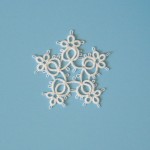 Tatting is a very old form of lace making. In ancient Egypt, funeral cloths were trimmed with knotting. (One theory is that tatting developed from knotting.) A combination of rings and chains create various edgings and motifs. The tatting stitch is actually a Lark’s Head knot which is transferred (flipped) along a core thread. This flipped Lark’s Head knot is called a double stitch—the basic stitch used in tatting.
Tatting is a very old form of lace making. In ancient Egypt, funeral cloths were trimmed with knotting. (One theory is that tatting developed from knotting.) A combination of rings and chains create various edgings and motifs. The tatting stitch is actually a Lark’s Head knot which is transferred (flipped) along a core thread. This flipped Lark’s Head knot is called a double stitch—the basic stitch used in tatting.
The double stitch is manipulated in a variety of ways to produce different effects. (There are a few other knots or stitches that play a supporting role in tatting such as the square knot and lock stitch.) Yet, the double stitch makes up the bulk of tatting patterns.
The easiest way to make a double stitch is with smooth, round thread. Round thread makes it easier to flip the Lark’s Head knot along the core thread. If a flat ribbon were used in place of a round thread, the flat ribbon would buckle. Buckling prevents the flipping of thread when making a double stitch. Any round thread can be used for tatting including kite string and copper beading wire. Most often, 100% cotton thread is used. If you use a shuttle to tat, then your thread shouldn’t have much “give” in it. On the other hand, if you use a needle to tat, then you can tat with any round fiber which includes yarn.
Historically, tatted lace graced table tops (doileys) and trimmed Victorian collars or quilts. Today, tatting is used on hair clasps, bracelets, ear rings, tree ornaments, and motifs for cards or a scrapbook.